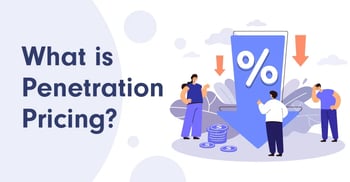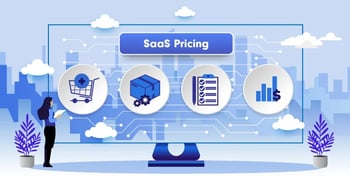Price Segmentation: Definition, Use Cases + Examples
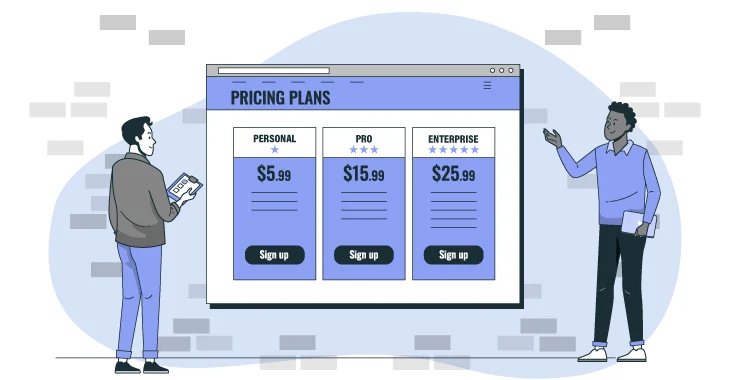
Determining the correct pricing structure for your SaaS product or service is a complex endeavor, yet regrettably, often overlooked by founders and CFOs. Investing just six hours to pinpoint the right price for your product in a $237.48 billion market is grossly insufficient.
And with SaaS prices never static and utterly dependent on customers, choosing the correct monetization strategy should always be an unfinished project.
Luckily, there is something that can give you a helping hand in this ongoing priority or at least enable you to approach this task from a fresh perspective: price segmentation.
Join us in better understanding this pricing strategy, as we will be closely looking at:
Why Does Price Segmentation Matter?
3 SaaS Price Segmentation Real-Life Examples
3 Best Practices For Effective Price Segmentation
What Are The Risks of Price Segmentation?
The Four-Step SaaS Price Segmentation Process
What is Price Segmentation?
The price segmentation strategy refers to the practice of charging different prices to different customer segments based on a number of criteria, including their willingness to pay.
The core concept driving this monetization tool is variable pricing, aimed at increasing revenue by considering specific customer data.
Instead of relying on a single price point, which can be a subject of debate, especially among price-sensitive customers, pricing segmentation creates several different revenue strategies for the same product while also taking into consideration consumer behavior.
Why Does Price Segmentation Matter?
Apart from being a helpful tool in identifying the optimal price for your product, segmented pricing is crucial for SaaS businesses operating worldwide because you can boost profitability from high-paying customers while winning accounts with lower spending power. But let’s look at the entire list of benefits the price segmentation strategy offers.
Increased Gains
No matter what you are selling or who is buying your product, you need to carefully handle the price sensitivity of your customer base. That’s why establishing the correct pricing strategy for your SaaS is such a tedious undertaking.
Implementing price segmentation solves this problem and helps you make sure that you are making a profit in all market segments.
Running a successful SaaS business usually involves increased operational costs. Charging a high single price for your product would, without a doubt, allow you to recover your investment and make a profit.
But what happens if your entire target audience isn’t ready to pay?
Well, you start losing money.
Segmented prices aimed at different customer groups allow you to generate the appropriate resources to ensure growth, capitalizing on an audience’s willingness to pay and then recovering operational costs from other lower-priced tiers.
Additionally, through the tiered pricing strategy, you can reduce operational expenses by limiting feature access from those lower priced tiers.
Versatile Marketing Approaches
Customer segmentation is a powerful tool in marketing, and the SaaS industry is no exception to this rule. Standing out in a competitive market can be challenging, so it’s important to make use of the best strategies for your business.
A segmented pricing strategy based on different tiers also gives the software company increased flexibility in developing various marketing approaches.
You can maximize sales potential and increase revenue by identifying each segment’s unique pain points targeting different customer groups.
Offering unique pricing packages for different segments gives your marketing team greater flexibility in crafting acquisition and retention strategies purposefully targeted to their unique needs.
High Growth Potential
While customer acquisition is a major concern for SaaS businesses, so is retention. It is customer retention that fuels sustainable growth. Introducing price segmentation in your monetization strategy allows you to make the most of various retention techniques.
From offering loyalty discounts to long-term clients to upselling existing users in order to boost customer lifetime value or customer satisfaction, segmented pricing allows you to adapt and evolve your monetization plan as you grow.
Moreover, price differentiation gives you increased flexibility to remain aligned with changing customer preferences and market conditions.
Faster Market Expansion
What’s the fastest way to gain attention in a competitive market? Lower prices.
Like the penetration monetization technique, where you break the barrier by pricing your product lower than your competition to gain market traction, having different pricing packages equates to fat market expansion.
A perfect example of this is streaming services like Netflix or Disney Plus that practice geographic pricing segmentation.
Keeping your prices competitive on a global scale improves customer satisfaction, undoubtedly leading to significant and steady revenue growth.
5 Types of Price Segmentation
To correctly implement price segmentation, you need to first identify the type of segmentation you wish to put into place. While there may be numerous ways to execute this pricing strategy, we will be looking at those that fit SaaS businesses.
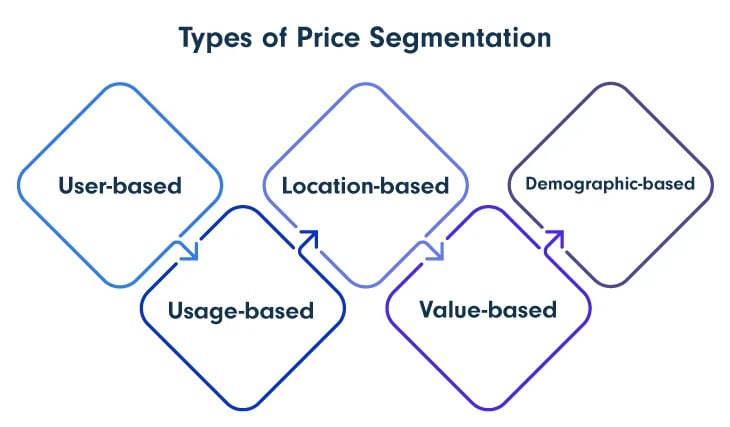
User-based pricing segmentation
Numerous SaaS businesses offer various pricing options based on the number of users or seats required. In this scenario, customers choose the package that aligns with their budget and needs.
This approach is scalable and simple to accommodate the requirements of different business sizes for anyone from startups to enterprises, and is also customer-centric. The user is free to identify the plan that fits their needs and the option to upgrade or downgrade in case those needs vary.
Usage-based pricing segmentation
Often mistaken for user-based, usage segmentation refers to developing different pricing strategies based on the amount of software utilization. This could be anything from data storage to the number of processed payments.
This approach gives the best results in industries where consumption levels can vary widely because the SaaS company practicing it gains a high level of flexibility.
Location-based pricing segmentation
Price segmentation based on your customer’s geographic location is a solid approach when looking to enter untapped markets. When calculating the differences between your pricing packages, you need to consider several things besides customer behavior.
Adjusting pricing based on your audience’s purchasing power is necessary for this strategy. For instance, Netflix has a higher price for customers in the European Union than those in India.
To achieve a successful price segmentation based on location, you need to perform thorough market research that takes into consideration the economic realities of the region you wish to expand in.
Value based pricing segmentation
When tailoring your pricing plans to different market segments based on the perceived value brought by your SaaS product, you are highlighting the specific benefits and features each package offers to its targeted audience.
To effectively perform this type of segmentation, you must carefully identify and separate customer segments based on pain points and key challenges. Then, you need to align your offer with their needs, thus enhancing overall product competitiveness and profitability.
As long as customers feel they are fairly priced for the received value, you can rest assured that you are doing a great job.
Demographic-based pricing segmentation
SaaS businesses tailor their pricing packages based on specific demographic factors like the targeted audience's age, income, or occupation. This approach is effectively implemented by creating packages that differ not only in price but also in a strong alignment of features and functionality.
For example, a freelancer’s needs are very different from those of SMBs or enterprises. Why should they pay for personalized customer support or system customizations when their business operations do not require such features?
3 SaaS Price Segmentation Real-Life Examples
The tiered pricing strategy is the most popular manner to highlight price segmentation within the SaaS industry. Let’s look at three examples of how big names in the software market crafted their pricing packages.
Microsoft 365
Offering essential products for a number of industries, Microsoft 365 goes pretty deep in price segmentation. This SaaS company works hard to identify customer segments, looking at a number of criteria and monetizing their services in different layers.
First, it segments its customers based on usage type, offering home and business use plans. Next, it focuses its pricing strategy on users. The monetization is performed per user, and packages differ in features.
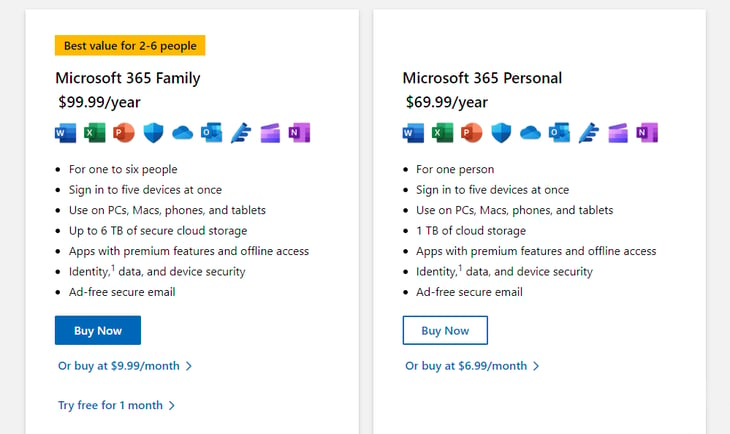
Moreover, Microsoft 365 uses pricing to its advantage, boosting brand image by offering special prices to more price sensitive customers, namely students. The packages for this category are only $2.99, the lowest price in their monetization scheme.

Crazy Egg
Crazy Egg, the web analytics and user behavior tracking tool, has gained an increased amount of popularity in the eCommerce world. Looking at how this SaaS business approaches its monetization strategy, it’s pretty obvious that Crazy Egg understands the power of correct pricing.
The road they decided to take is usage-based segmentation, creating different tiers that offer each customer group-specific value. The more utilized the software is, the higher the price.
Additionally, it is worth noting that Crazy Egg has a custom pricing plan dedicated to enterprise businesses, an audience segment in which higher prices are practiced and advanced product features and personalized services are offered.
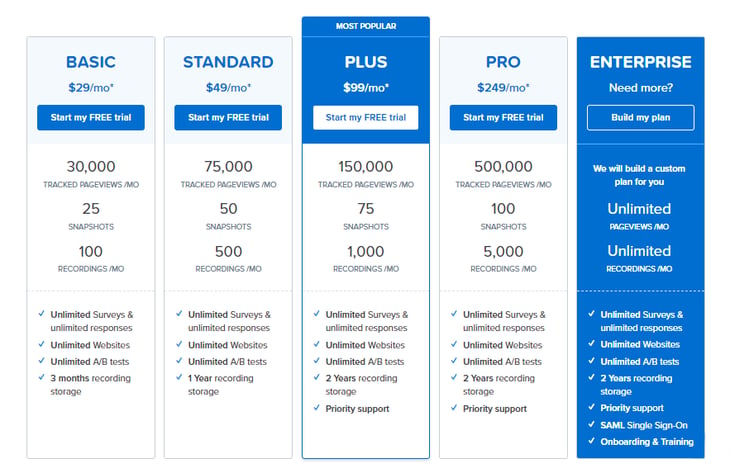
Dropbox
Now a household brand, Dropbox has mastered its pricing strategy.
This cloud-based file storage and synchronization service's main approach is based on usage dictated by business size, from personal use to large-scale business. Each package has specific features aligned with the user’s operational needs.
An additional layer is added to Dropbox’s monetization strategy: utilization preferences. Users can select if they wish to pay solely for data storage or require extra features.
This is the first step in Dropbox’s price segmentation pricing strategy.
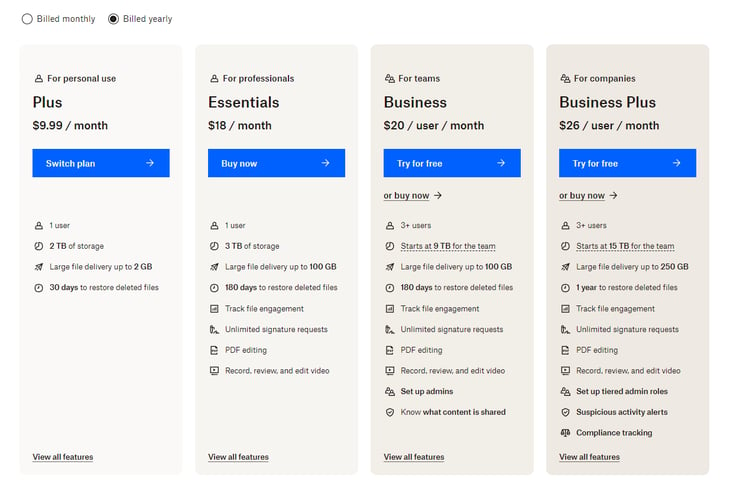
3 Best Practices For Effective Price Segmentation
Price segmentation is the kind of strategy that can be successfully implemented at any point in your business evolution as long as you consider a few points.
Perform thorough customer research
The core principle of price segmentation is correctly identifying customer segments. This, of course, requires extensive research. You need to carefully assess your target audience and understand not only their key pain points but also their growth goals and spending power.
To make sure you are performing this task correctly, you might want to include all of your company departments. Your sales, marketing, and customer support teams should be able to provide you with key insights into customer behavior based on their interactions with existing or potential users.
It’s important to mention that while research is relevant in both scenarios, buyer personas and customer segments are not the same thing. Their purposes are different, and so is the type of information required in creating these profiles.
Yes, they are similar, but at the end of the day, customer segments are used to optimize pricing strategy and identify price sensitivity. In contrast, buyer personas carry significant value for brand strategy.
Company information, like revenue goals, the complexity of operational cycles, the number of employees, and spending power, are some details that help you create highly accurate segments.
Monitor your pricing techniques
Monetization strategies, in general, evolve, just like industries and customers’ needs and preferences. Price segmentation makes no exception to this rule.
Even if you’ve established your customer segments, you need to constantly review them and determine if changes are in order.
Continually tracking your monetization strategy, the efficiency of your pricing plans, and the feature needs of your customers is necessary because alignment is essential for sustainable growth.
Once you gain relevant knowledge of how your audience is reacting to your price segments, you can further refine your strategy.
So, decide your top metrics, set benchmarks, and religiously perform data monitoring per segment.
Consider tracking your customer acquisition rate (CAC) to understand if the price aligns with your acquisition expenses, churn rate, gross profit margin, and customer lifetime value (CLV).
Invest in a robust billing system
Pricing is a big part of your business’s success. It’s a machine that can take your SaaS product for as long as it is taken care of properly. But what does this mean exactly?
No matter how potentially productive establishing a solid strategy is, it can’t yield the expected results if you do not have a strong infrastructure you can rely on to sustain your efforts.
Practicing different prices for various customer segments requires a strong system that can streamline the billing process. You need a platform that efficiently handles numerous pricing models, free trials and freemiums, and discounts. Pricing tools that can help your business scale through cross-selling and upselling techniques are just as crucial for long-term growth.
Additionally, when performing price segmentation based on user location, you should consider seasoning your offer with localization strategies like customer-preferred payment methods, local currencies, and regional pricing.
What Are The Risks of Price Segmentation?
It's widely acknowledged that price segmentation is a valuable strategy for monetizing products. Yet, like any strategy, there are certain aspects that SaaS founders should be aware of and consider when implementing it.
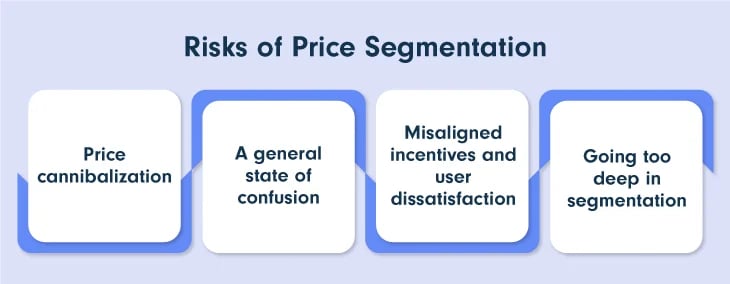
Price cannibalization
What is one of the essential elements that fuels customer segmentation? How willing to pay the user is.
In a nutshell, when price segmentation is correctly implemented, higher prices are reserved for clients with an increased willingness to pay.
But sometimes, things don’t work out as planned.
Customers within the high-price segment could easily migrate to the lower price, reducing your profits and eliminating the benefits of price segmentation.
To avoid this scenario, when crafting your pricing plans and packages, make sure you are effectively setting up price fences and feature offers so that customers remain in their established segments. In other words, make it impossible for them to choose a different price than what you envisioned.
A general state of confusion
Having multiple and attractive prices to meet business and user needs is the smart way to demonstrate how customer-centric your SaaS product is. But you don’t want to come across as confusing, either.
One of the price segmentation risks is the inability to get your monetization message across, leaving both your employees and customers confused and frustrated. And unfortunately, instead of boosting your conversions, you are feeding your churn rates.
Plan to provide precise details as to what each pricing plan includes to eliminate misunderstandings and reduce user friction. Also, make sure you are offering sufficient price-related information to your staff so they are able to present your offer convincingly.
Offer product training to your key specialists within the sales, marketing, and support departments to ensure they can adequately help in the customer purchasing and transition process.
Misaligned incentives and user dissatisfaction
Out of the desire to hit company KPIs and maximize commissions, your sales and marketing teams might be focused on selling and prioritizing your highest-priced plans.
As you might imagine, this can anger certain customer segments when they notice their needs are ignored or when they are recommended unsuitable pricing plans.
Price segmentation has the power to improve customer satisfaction as long as all user groups are treated equally and they feel their needs are being met in their price tier.
You must understand each customer segment, develop a fair monetization strategy that matches specific business needs, and communicate your offer clearly.
All users matter, and they must all feel like they are treated equally.
Going too deep in segmentation
Out of a desire to serve as many users as possible, to boost profit margins, and to optimize multiple revenue streams, SaaS businesses risk getting lost in their segmentation efforts.
This not only consumes a significant amount of time but also places a heavy demand on resources, eventually reaching a point where it becomes counterproductive.
With market and customer behaviors evolving at a rapid pace, you will constantly have to review your price segments, and the more you have, the more this task will drain you of energy, resources, and money.
Avoid overcomplicating your pricing structure, as this leads to in-house and external confusion, ultimately affecting your revenue. Keep it simple, clear, and easy to monitor and improve.
The Four-Step SaaS Price Segmentation Process
Even though there isn’t a one-size-fits-all approach to price segmentation, there are several steps that all SaaS businesses need to take to successfully implement proper price segmentation.
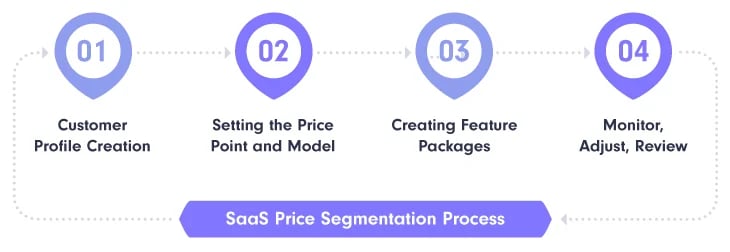
Step one: Segmentation Analysis and Customer Profile Creation
Research is where everything starts. Look into your audience target and check behavioral patterns, preferences, and spending habits.
Also, include data on company size, industry, and geographic location. The more detailed your analysis is, the more accurate your price segmentation strategy will be.
Once you’ve gathered sufficient information, start building your groups. Create detailed buyer profiles for each customer segment, which include pain points, goals, and financial specifics. These will represent the foundation of your monetization strategy, so make sure you have a lot of data to work with.
Step two: Setting the Price Point and Model
When implementing price segmentation, or any monetization strategy for that matter, you need to consider two things: your product and your customer. Looking solely at one won’t suffice.
So, depending on how your SaaS brings value to its users and how you’ve decided to segment your target audience, you can decide on the best pricing model to highlight that. It can be anything from per-user pricing to usage or value-based pricing.
As for price point setting, you need to consider your users. This is where your previous data collection comes in handy. Look into your user profile, consider their willingness to pay, conduct pricing surveys and A/B tests to set the most appropriate price point, and then fine-tune your strategy.
Step three: Create feature packages, communicate and train
The key to mastering segmentation pricing is to effectively align product features with customer needs. If your customer segments find everything they need to streamline their business operations within your packages, they will be willing to pay the price.
While there is no magic number when it comes to pricing tiers, you need to effectively and clearly communicate what each offer stands for. Develop targeted marketing and messaging strategies that speak directly to the challenges familiar to each user segment.
Also, make sure your sales department thoroughly understands the differences in price plans to suggest the right option for each potential customer.
Step four: Monitor, Adjust, Review
When practicing the price segmentation strategy, keeping an eye on data and KPIs is imperative. This strategy is dependent on consumer behavior, which is continuously changing. This means that your segmented prices might require regular adjustments.
Staying aligned with industry changes and user behaviors is an absolute must if you want to run a successful and rewarding monetization strategy. So, monitor constantly, adjust adequately, and review on a regular basis.
Thrive with the industry’s most innovative all-in-one SaaS & Digital Goods solution. From high-performing payment and analytics tools to complete tax management, as well as subscription & billing handling, PayPro Global is ready to scale your SaaS.
Sell your SaaS globally with PayPro Global!
How Can PayPro Global Help?
Implementing strong pricing strategies cannot be achieved unless you can rely on a robust monetization platform that can sustain it. But what does this mean exactly?
PayPro Global is an all-in-one eCommerce solution that helps SaaS businesses sell their products anywhere in the world.
By providing users with a powerful pricing engine, you can test different monetization strategies, models, and techniques, ensuring you can find the right business fit for your SaaS. From discounts and promotions to tiered pricing or user-based, PayPro Global’s unified solution can help you fine-tune all of your strategies.
Offering you the right mix of payment methods and currencies, 28 supported languages, and branded checkouts, we make it easy for your users to pay for your product’s SaaS features.
With access to PayPro Global’s powerful subscription engine, packed with growth-oriented features like automatic subscriptions and customized charges, including upgrading or on-demand transactions, you can lower your churn rate and optimize your operational workload.
Moreover, since data is king, you can collect extensive user-based information to adjust your plans and achieve better customer need alignment, all thanks to PayPro Global’s AI-driven SaaS analytics and BI tools.
Visit PayPro Global or reach out to find out how we can help you stay on top of your SaaS pricing strategy.
Final Thoughts
There is no doubt that price segmentation can be extremely rewarding for SaaS businesses when done correctly. Conditional pricing can help boost your profits and market share, and it can position your brand in a manner that will lead to long-term success.
Once your customer base understands that they are fairly priced and are getting their money’s worth, retaining them over prolonged periods of time becomes much simpler.
The only rule here is to monitor, adjust, and review, all on a regular basis.
Ioana Grigorescu
Ioana Grigorescu is PayPro Global's Content Manager, focused on creating strategic writing pieces for SaaS, B2B, and technology companies. With a background that combines Languages and Translation Studies with Political Sciences, she's skilled in analyzing, creating, and communicating impactful content. She excels at developing content strategies, producing diverse marketing materials, and ensuring content effectiveness. Beyond her work, she enjoys exploring design with Figma.
-
1.Explore PayPro Global's Solutions: See how our platform can help you streamline your payment processing and boost revenue.
-
2.Get a Free Consultation: Discuss your specific needs with our experts and discover how we can tailor a solution for you.
-
3.Download our Free Resources: Access valuable guides, checklists, and templates to optimize your online sales.
-
4.Become a Partner: Expand your business by offering PayPro Global's solutions to your clients.
Get the latest news


